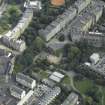Edinburgh, Canonmills, Scotland Street Tunnel And North Portal
Railway Tunnel (19th Century)
Site Name Edinburgh, Canonmills, Scotland Street Tunnel And North Portal
Classification Railway Tunnel (19th Century)
Alternative Name(s) Royal Crescent; Caledonia Street; Leith And Newhaven Railway; Scotland Street Goods Depot; Station
Canmore ID 281267
Site Number NT27SE 1297.01
NGR NT 25463 74825
Datum OSGB36 - NGR
Permalink http://canmore.org.uk/site/281267
- Council Edinburgh, City Of
- Parish Edinburgh (Edinburgh, City Of)
- Former Region Lothian
- Former District City Of Edinburgh
- Former County Midlothian
NT27SE 1297.01 25463 74825
Leith and Newhaven Railway, Scotland Street Tunnel - line between Edinburgh and Newhaven opened 1846.
(Undated) information in NMRS.
(Location cited as NT 254 748 to NT 257 740). Scotland Street Tunnel, Canonmills, opened 1847 by the Edinburgh, Leith and Granton Rly: engineers Grainger and Miller. Constructed on a gradient of 1 in 27 and worked by cable haulage. Closed since 1968, but still intact. The southern entrance is obscured, but the monumental northern portal is still visible.
J R Hume 1976.
This tunnel measures 1000yds [915m] in length, 24ft [7.3m] in width, and 24ft [7.3m] in height, and has a gradient of 1-in-27 towards the N. The S end now emerges into the NW side of Waverley Station (NT27SE 221.00). Passenger carriages proceeding downhill (northwards) were steadied by brake trucks, while those heading uphill were hauled by an endless rope, which ran under rollers beneath the rails and was powered by a stationary steam engine at Canal St Station [now incorporated into the Waverley Station].
After closure, the tunnel continued to have a significant role in defining railway development within Edinburgh, possible impingement upon it being a major constraint on a projected Caledonian Rly underground line along Princes St. It has also been used for growing mushrooms, as a bombproof LNER railway control centre in the Second World War, as a location for the observation of natural radiation, and for car storage.
A J Mullay 1991.
The location assigned to this record is an interpolated estimate of the midpoint of the length. The N portal (NT27SE 1297.01) survives intact, but the S end is represented by a grated entrance opposite platform 19 within the NW part of Waverley Station (NT27SE 221.00). A prominent sign-plate records the significance of this feature, which need not be the original portal. In the absence of a verified location or appropriate map evidence, a location at NT c. 2570 7387 is assigned.
Information from RCAHMS (RJCM), 16 May 2006.
Construction (1844 - 1847)
Project (2007)
This project was undertaken to input site information listed in 'Civil engineering heritage: Scotland - Lowlands and Borders' by R Paxton and J Shipway, 2007.
Publication Account (2007)
This tunnel built from 1844–47 on the main railway north, the Edinburgh, Leith & Granton Railway (from 1847 the Edinburgh, Perth & Dundee), was used for only two decades before being closed on 22 May 1868. It is 3210 ft long on a gradient of 1 in 27, built mainly in brickwork, and is 26 ft wide with an elliptical arched roof 18 ft high in the centre. In-bound trains were hauled up the incline through the tunnel to the company’s Canal Street terminus at Waverley Bridge Station by means of a stationary steam-operated winding engine – a system that was inconvenient and expensive to operate and was closed down six years after being acquired by the North British Railway. The tunnel was designed by Grainger, with George Buchanan superintending the works for the City’s interest. The resident engineer, who devised ingenious temporary works and prepared a longitudinal section showing the strata, was William Paterson. The contractors were Ross & Mitchell.
For about 20 years after its closure, until the 1920s, the tunnel was used for growing mushrooms on both sides of one line of track on which a North British locomotive operated. Almost the full length of tunnel was used and there were three miles of mushroom beds consisting of 3000 tons of soil and manure. Mushrooms that had been growing in the tunnel three hours earlier were delivered
to Glasgow by 10am daily.
R Paxton and J Shipway 2007
Reproduced from 'Civil Engineering heritage: Scotland - Lowlands and Borders' with kind permission of Thomas Telford Publishers.
























